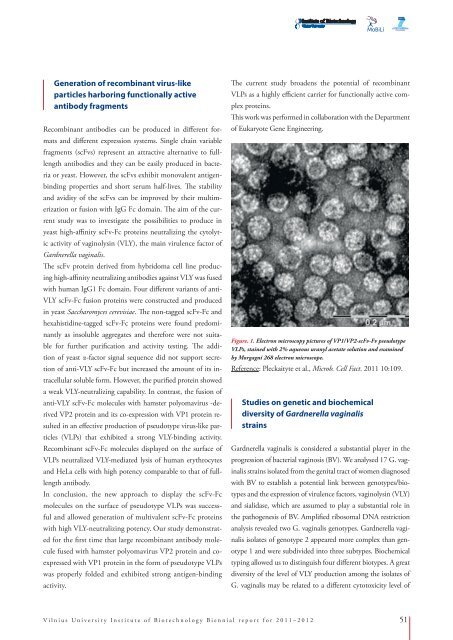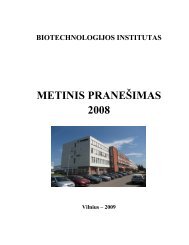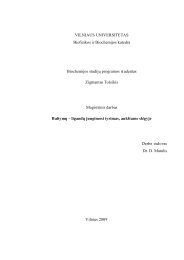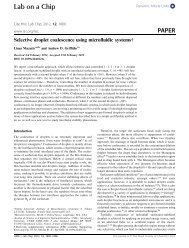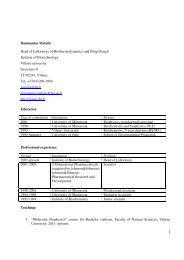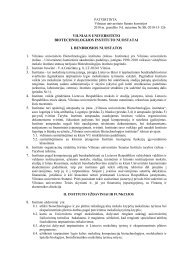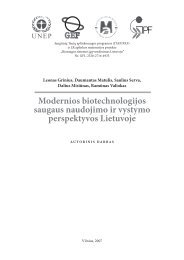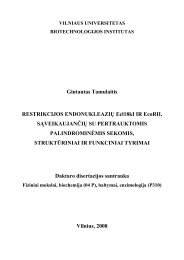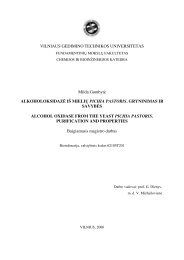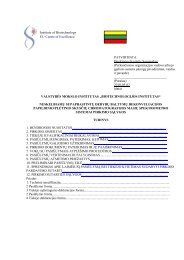Biennial Report 2011â2012
Biennial Report 2011â2012
Biennial Report 2011â2012
Create successful ePaper yourself
Turn your PDF publications into a flip-book with our unique Google optimized e-Paper software.
Generation of recombinant virus-like<br />
particles harboring functionally active<br />
antibody fragments<br />
Recombinant antibodies can be produced in different formats<br />
and different expression systems. Single chain variable<br />
fragments (scFvs) represent an attractive alternative to fulllength<br />
antibodies and they can be easily produced in bacteria<br />
or yeast. However, the scFvs exhibit monovalent antigenbinding<br />
properties and short serum half-lives. The stability<br />
and avidity of the scFvs can be improved by their multimerization<br />
or fusion with IgG Fc domain. The aim of the current<br />
study was to investigate the possibilities to produce in<br />
yeast high-affinity scFv-Fc proteins neutralizing the cytolytic<br />
activity of vaginolysin (VLY), the main virulence factor of<br />
Gardnerella vaginalis.<br />
The scFv protein derived from hybridoma cell line producing<br />
high-affinity neutralizing antibodies against VLY was fused<br />
with human IgG1 Fc domain. Four different variants of anti-<br />
VLY scFv-Fc fusion proteins were constructed and produced<br />
in yeast Saccharomyces cerevisiae. The non-tagged scFv-Fc and<br />
hexahistidine-tagged scFv-Fc proteins were found predominantly<br />
as insoluble aggregates and therefore were not suitable<br />
for further purification and activity testing. The addition<br />
of yeast α-factor signal sequence did not support secretion<br />
of anti-VLY scFv-Fc but increased the amount of its intracellular<br />
soluble form. However, the purified protein showed<br />
a weak VLY-neutralizing capability. In contrast, the fusion of<br />
anti-VLY scFv-Fc molecules with hamster polyomavirus -derived<br />
VP2 protein and its co-expression with VP1 protein resulted<br />
in an effective production of pseudotype virus-like particles<br />
(VLPs) that exhibited a strong VLY-binding activity.<br />
Recombinant scFv-Fc molecules displayed on the surface of<br />
VLPs neutralized VLY-mediated lysis of human erythrocytes<br />
and HeLa cells with high potency comparable to that of fulllength<br />
antibody.<br />
In conclusion, the new approach to display the scFv-Fc<br />
molecules on the surface of pseudotype VLPs was successful<br />
and allowed generation of multivalent scFv-Fc proteins<br />
with high VLY-neutralizing potency. Our study demonstrated<br />
for the first time that large recombinant antibody molecule<br />
fused with hamster polyomavirus VP2 protein and coexpressed<br />
with VP1 protein in the form of pseudotype VLPs<br />
was properly folded and exhibited strong antigen-binding<br />
activity.<br />
The current study broadens the potential of recombinant<br />
VLPs as a highly efficient carrier for functionally active complex<br />
proteins.<br />
This work was performed in collaboration with the Department<br />
of Eukaryote Gene Engineering.<br />
Figure. 1. Electron microscopy pictures of VP1/VP2-scFv-Fv pseudotype<br />
VLPs, stained with 2% aqueous uranyl acetate solution and examined<br />
by Morgagni 268 electron microscope.<br />
Reference: Pleckaityte et al., Microb. Cell Fact. 2011 10:109.<br />
Studies on genetic and biochemical<br />
diversity of Gardnerella vaginalis<br />
strains<br />
Gardnerella vaginalis is considered a substantial player in the<br />
progression of bacterial vaginosis (BV). We analysed 17 G. vaginalis<br />
strains isolated from the genital tract of women diagnosed<br />
with BV to establish a potential link between genotypes/biotypes<br />
and the expression of virulence factors, vaginolysin (VLY)<br />
and sialidase, which are assumed to play a substantial role in<br />
the pathogenesis of BV. Amplified ribosomal DNA restriction<br />
analysis revealed two G. vaginalis genotypes. Gardnerella vaginalis<br />
isolates of genotype 2 appeared more complex than genotype<br />
1 and were subdivided into three subtypes. Biochemical<br />
typing allowed us to distinguish four different biotypes. A great<br />
diversity of the level of VLY production among the isolates of<br />
G. vaginalis may be related to a different cytotoxicity level of<br />
Vilnius University Institute of Biotechnology <strong>Biennial</strong> report for 2011–2012 51


